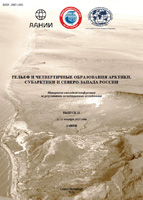| ||
|
| ||
|
doi: 10.24412/2687-1092-2024-11-721-728 1A.P. Karpinsky Russian Geological Research Institute, St. Petersburg, Russia 2St. Petersburg State University, St. Petersburg, Russia
|
|
Abstract. In 2024, the Khanka squad of the Khabarovsk party, employees of the Department of Regional Geoecology and Marine Geology, completed the work on Lake Khanka (Primorsky Krai) as part of a state assignment to further study the Quaternary sediments of the water area. Office processing included an analysis of geological and geophysical data with the interpretation of time sections, granulometric and geochemical analyses. Based on the results of the work, the boundaries of reflecting horizons were established, the types of motogenesis of sand deposits was put forward, and differences in heavy metal concentrations in surface sediments were revealed. Based on the obtained data and published sources, an assessment of the age and origin of the studied water area’s sediments was carried out. They are represented by lacustrine and lacustrine-nepheloid sediments of the Upper Neopleistocene-Holocene, in shallow water areas, by lacustrine-undaluvial ones. Keywords: Lake Khanka, Quaternary deposits, geological and geophysical data, granulometric analysis, motogenesis, geochemical analysis, heavy metal concentrations, age, origin
REFERENCES: Bazarova V.B., Mokhova L.M., Orlova L.A., Belyanin P.S., Variation of the Lake Khanka level in the late Holocene, Primorye // Russian Journal of Pacific Geology. 2008. Vol. 27. No. 3. P. 272-276. doi: 10.1134/S181971400803007X State Geological Map of the Russian Federation. Scale 1: 1,000,000 (third generation). Sheet (L-(52), 53; (K-52, 53) – Lake Khanka. Explanatory note. – SPb.: VSEGEI cartographic factory, 2011. – p. 684 + 8 incl. History of Lake Ladoga, Onega, Pskov-Chudskoe, Baikal and Khanka (Series: History of Lakes of the USSR). L.: Nauka, 1989. – 280 p. Korotkiy A.M., Mikhailov M.A., Kitaev I.V., Kurnosov V.B., Lithology and geochemistry of modern lake sediments of the humid zone (on the example of Lake Khanka), M.: Nauka, 1979. P. 6, 9-11. Lake Khanka [Electronic resource] // Wetlands of Russia: website. – URL: https://fesk.ru/wetlands/298.html (access date: 06/20/2024). Mikishin Yu.A., Petrenko T.I., Popov A.N., Orlova L.A., Paleogeography of Lake Khanka in the late Holocene // Scientific Review. 2007. No. 2. P. 8-9. Ovodova E.V., Geochemical study of soils of the Pavlovsk brown coal field within the “Pavlovsky-2” section // Bulletin of the Engineering School of the Far Eastern Federal University. 2013. No. 3. P. 66-72. Pavlyutkin B.I., Khanchuk A.I. New data on the age of Lake Khanka, the russian Far East // Doklady Earth Sciences. 2002. Vol. 383. № 2. P. 187-189. Swedish Environmental Protection Agency (EPA). Environmental quality criteria – Lakes and watercourses. Report 5050. Swedish Environmental Protection Agency, Stockholm, 2000. – 105 p. Tarasenko I.A., Zinkov A.V., Estimation of technogenic pollution of groundwater basin around the abandoned mine (the Lipovetskoe coal deposit, Primorsky Krai) // Bulletin of the Far Eastern Branch of the Russian Academy of Sciences. 2013. No. 2 (168). P. 106-115.
|
|
Cite this article: Rumyantseva A.K., Sergeev A.Yu., Budanov L.M., Dron O.V., Ryabchuk D.V. Data on the study of quaternary deposits of Lake Khanka // Relief and Quaternary deposits of the Arctic, Subarctic and North-West Russia. 2024. Issue 11. P. 721-728. doi: 10.24412/2687-1092-2024-11-721-728
|

